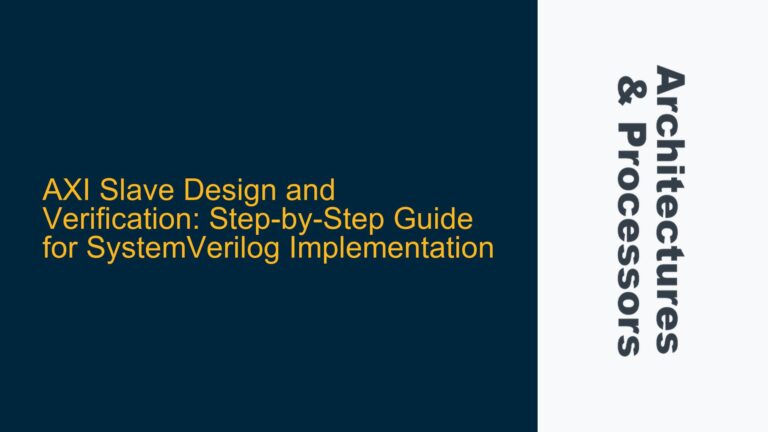AXI Write Strobe Signals and Their Impact on Read-Modify-Write Operations
The AXI (Advanced eXtensible Interface) protocol is a widely used on-chip communication standard for high-performance embedded systems. One of its key features is the ability to perform efficient data transfers using write strobe signals (WSTRB). These signals determine which byte lanes of the data bus are valid during a write transaction. However, the behavior of these strobe signals, particularly when manipulated to force specific write patterns, can lead to unintended consequences such as read-modify-write (RMW) operations. Understanding the relationship between write strobes and RMW behavior is critical for optimizing performance and ensuring protocol compliance.
In a typical AXI write transaction, the WSTRB signals indicate which bytes of the write data (WDATA) are valid. For example, in a 32-bit write transaction, a WSTRB value of 0xF (binary 1111) indicates that all four bytes are valid. However, if the WSTRB is modified to 0xC (binary 1100), only the upper two bytes are valid, and the lower two bytes are considered invalid. This manipulation raises questions about whether the AXI protocol allows such modifications to force RMW operations and how subordinate devices (e.g., memory controllers or peripherals) handle these cases.
The AXI protocol does not explicitly define the internal behavior of subordinate devices when handling partial writes. Instead, it provides guidelines for how WSTRB signals should be interpreted. Subordinate devices may implement byte-level writes directly if supported by the hardware, or they may internally perform RMW operations to update only the specified bytes. This ambiguity can lead to performance bottlenecks, especially in systems where RMW operations are costly in terms of latency and power consumption.
Protocol Ambiguities and Subordinate Device Implementation Variability
The core issue lies in the variability of how subordinate devices interpret and handle WSTRB signals. The AXI protocol specifies that WSTRB signals indicate which byte lanes are valid, but it does not mandate how subordinate devices should process these signals. This lack of specificity can lead to inconsistent behavior across different implementations, particularly when WSTRB signals are manipulated to force partial writes.
For example, consider a 32-bit write transaction with a WSTRB value of 0xC (binary 1100). The protocol states that the lower two bytes are invalid, but it does not specify whether the subordinate device should perform a RMW operation to update only the upper two bytes or ignore the invalid bytes entirely. If the subordinate device supports byte-level writes, it may update only the specified bytes without performing a RMW operation. However, if the device does not support byte-level writes, it may internally perform a RMW operation to update the target memory location.
This variability is further complicated by unaligned write transactions. In an unaligned write, the WSTRB signals may span multiple memory locations, requiring the subordinate device to perform multiple RMW operations to update the target memory. For example, a 32-bit write transaction starting at address 1 with a WSTRB value of 0xE (binary 1110) would require the subordinate device to update bytes at addresses 1, 2, and 3. If the device does not support byte-level writes, it may need to perform a RMW operation for each affected memory location, significantly increasing latency and reducing performance.
The ambiguity in the AXI protocol also extends to the handling of invalid WSTRB signals. The protocol states that WSTRB signals set to 0 indicate invalid data, but it does not specify how subordinate devices should handle these cases. Some devices may ignore invalid bytes entirely, while others may treat them as don’t-care values and perform unnecessary RMW operations. This inconsistency can lead to unexpected behavior and performance degradation, particularly in systems with strict timing requirements.
Diagnosing and Resolving WSTRB-Related RMW Issues
To diagnose and resolve issues related to WSTRB manipulation and RMW behavior, engineers must first understand the specific implementation of the subordinate device. This involves analyzing the device’s datasheet or technical documentation to determine how it handles WSTRB signals and whether it supports byte-level writes. If the device does not support byte-level writes, engineers must assume that RMW operations will occur and optimize their system accordingly.
One approach to mitigating RMW-related performance issues is to ensure that all write transactions are aligned and use full WSTRB values. This minimizes the likelihood of partial writes and reduces the need for RMW operations. For example, in a 32-bit write transaction, engineers should ensure that the write address is aligned to a 4-byte boundary and that the WSTRB value is set to 0xF (binary 1111). This ensures that all bytes are valid and eliminates the need for RMW operations.
If partial writes are unavoidable, engineers should consider using a memory controller or peripheral that supports byte-level writes. This allows the device to update only the specified bytes without performing RMW operations, improving performance and reducing latency. Additionally, engineers should carefully review the AXI protocol specification and ensure that their implementation adheres to its guidelines. This includes properly handling WSTRB signals and avoiding protocol violations that could lead to unexpected behavior.
In cases where RMW operations are unavoidable, engineers should optimize their system to minimize their impact. This may involve using caching mechanisms to reduce memory access latency or implementing custom logic to handle partial writes more efficiently. For example, a custom memory controller could be designed to buffer partial writes and combine them into full writes, reducing the number of RMW operations required.
Finally, engineers should thoroughly test their system to identify and address any WSTRB-related issues. This includes simulating various write scenarios and analyzing the behavior of the subordinate device. By understanding how the device handles WSTRB signals and RMW operations, engineers can optimize their system for performance and ensure compliance with the AXI protocol.
Conclusion
The manipulation of AXI write strobe signals (WSTRB) can have significant implications for system performance, particularly when it forces read-modify-write (RMW) operations. The ambiguity in the AXI protocol regarding how subordinate devices handle WSTRB signals can lead to inconsistent behavior and performance bottlenecks. To address these issues, engineers must carefully analyze the implementation of their subordinate devices, optimize their write transactions to minimize partial writes, and consider using hardware that supports byte-level writes. By understanding the relationship between WSTRB signals and RMW behavior, engineers can design more efficient and reliable embedded systems.






